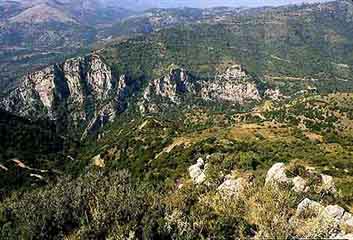
The Lousios Gorge seen from Ypsous/Stemnitsa
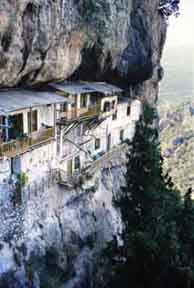
Agios Ioannis Prodromos (near Ypsous)
Arkadia
Karytaina
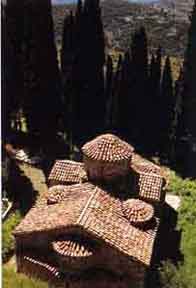
Malerisches Dorf (50 km w von Tripolis) im Lykaion-Gebirge, an der Schlucht des Alphaios gelegen und von einer Burg überragt. Im Mittelalter war Karytäna Sitz einer der fünf Baronien Arkadiens. Panagia-Kirche: Sie stammt aus dem 11. Jh. und besitzt eine mit Ornamenten und Vögeln bemalte Ikonostase. Agios Nikolaos: Kirche mit kreuzförmigem Grundriß und fünf Kuppeln, geschmückt mit Fresken, die allerdings beschädigt sind. Die Kapelle des Agios Andreas hat am westlichen Ende die Form einer Basilika und am östlichen die eines halben Kreuzes. Burg: Sie wurde 1209 von der Familie de Bruyeres erbaut und 1320 an die Paläologen abgetreten. 1460 beherrschten sie die Türken. Durch den Torbogen gelangt man in einen Burghof. S davon eine große Empfangshalle, im N ein viereckiger Turm.
Umgebung (l Stunde Fußmarsch): Die schönen, aber noch unerforschten Grotten von Kowia.
Gortys (2 Stunden Fußmarsch von Karytäna aus): Ausgrabungsarbeiten der Französischen Schule, die zwei Asklepios-Heiligtümer freilegte. Am linken Ufer des Lousios ein Heiligtum, das Mitte des 4. Jh. begonnen wurde, aber unvollendet blieb. Ende des 4. Jh. entstand ein Thermenbau, der wiederum im 3. Jh. veränden wurde. Im SO Häuser hellenistischer und römischer Zeit. -Asklepieion (nur wenige Überreste) sw der Akropolis, gegen Ende des 5. oder Anfang des 4. Jh. als dorischer Peripteros gebaut. Das Asklepios-Bad (Ende 3. Jh.) lehnte sich an eine Stoa, die als Abaton diente.
The Lousios Gorge and its Monasteries
|
The Lousios Gorge seen from Ypsous/Stemnitsa
|
Agios Ioannis Prodromos (near Ypsous) |
Moni Tou Philosphou (best reached from Dimitsiana)
The new Monastery of Philosophos, which was built in order to replace the earlier, Byzantine one, lies in the western part of the Lousios gorge and was founded at the middle of the 17th century. The catholicon (main church) is a cross-in-square domed church of the composite, four-column type, with plain facades and poor brickwork decoration. The wall paintings inside the church are dated to 1663 and are the work of Victor, a representative of the Cretan School. The church also has an impressive wooden-carved iconostasis.
Its catholicon was built by the monks of the new monastery and was painted at the expense of Mavraidis Pasha from Stemnitsa. From the mid-17th to the mid-18th century the new monastery housed the school of the Gortyn clergy which was attended by important people of the Church (e.g. Patriarch Gregory V). Between 1834 and 1836 the monastery was abolished with the decision of the Bavarian regency, its property was confiscated and sold.
The building of the cells to the SW of the catholicon has been consolidated and restored and access passages have been constructed by the Archaeological Service. The north wing of the cells building and the catholicon are going to be restored soon. Today, the monastery is used as a convent for monks, and is a department of the Monastery of Timios Prodromos (St. John the Forerunner) at Stemnitsa.
Many religious buildings have been located in the gorge of Lousios, including churches, monasteries, hermitages as well as secular buildings such as water-mills, gunpowder-mills, tobacco-mills etc. Some of the most important religious buildings are the Old Monastery of Panaghia (Our Lady) Philosophou, built in the 10th century, the Monastery of Timios Prodromos, dated to the end of the 16th century, the Monastery of Aimyales, the old and new monasteries of Atsicholos and St. Andrew at Gortyna
Lykosoura, The Archaeological Museum
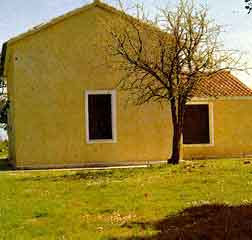
The small museum consisting of only one room, was founded at the end of the last century by Konstantinos Kourouniotis, in order to house some of the findings from the sanctuary of Despoina at Lykosoura.
The most important items in the museum are: Parts of the sculptured group of Damophon. It represented four local deities on a pedestal; Demeter and Despoina in the middle and Artemis and Titan Anytos at either ends. The other half of the group is at the National Archaeological Museum in Athens.
Clay votive offerings from the Megaron (Altar) of the sanctuary of Despoina . They include idols or small plaques , bearing representation of demons with donkey-like and ram-like heads. The same decoration is also found at the veil of the marble statue of Despoina. A Marble table which is supported by legs ending in lion like feet. Marble candelabrum, which was offered to the sanctuary of Despoina.
Monastery of the Metamorphosis at Loukou
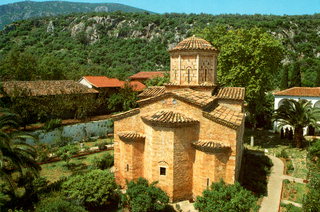
The moni lies to the NW of Astros, in the area of ancient Thyreatis, which is full of antiquities. It was probably built on the site of an Early Christian church of the 5th century A.D. The catholicon is a domed church of a composite four columned, cross-in-square type. It is decorated with fine wall paintings and its floor is paved with coloured marble slabs. The wall masonry imitates a careless "cloisonne", and includes ancient architectural parts and brick ornaments. The iconostasis is decorated with portable icons datinmg from the 17th century.
The first literary reference to the monastery is in the "Geographica" of Meletios, the Metropolitan Bishop of Athens in 1690. The roof of the has been retiled, the two-storeyed tower has been supported and the cells have been restored. In the 1980's the painted decoration of the church was systematically preserved and in 1994-95 the mosaic floor of the catholicon was restored. Today the monument is a convent for nuns.